Honorary Marine Corey DePooter, Eleven Classmates, and a Teacher on the Columbine Memorials
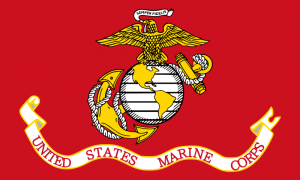 Corey DePooter’s goal in life was to become a Marine. He proved his valor at Columbine High School in Littleton, Colorado on April 20, 1999 when he kept his cool and calmed his two friends while facing the horror of an armed attack. Corey was the last person killed. The Marines have done this for less than 100 in their history, naming Corey an Honorary Marine and placing a Marine insignia on his grave site in a 2000 military ceremony. Veterans Day is for veterans. Corey earned that honor.
Corey DePooter’s goal in life was to become a Marine. He proved his valor at Columbine High School in Littleton, Colorado on April 20, 1999 when he kept his cool and calmed his two friends while facing the horror of an armed attack. Corey was the last person killed. The Marines have done this for less than 100 in their history, naming Corey an Honorary Marine and placing a Marine insignia on his grave site in a 2000 military ceremony. Veterans Day is for veterans. Corey earned that honor.
Like Corey, Dave Sanders died heroically that day, running toward the gunshots and directing students away. He served his country as a respected teacher and coach. But the eleven students who died with Corey and Dave did not get their chance to serve their country in whatever way they would have chosen, including simply contributing to the economy. One student, John Tomlin, was planning to join the Army. Steven Curnow, the youngest victim at age 14, expressed interest in the Navy. We’ll give them honorary veteran status today also. They join nine murdered students – Cassie Bernall, Kelly Fleming, Matthew Kechter, Daniel Mauser, Daniel Rohrbough, Rachel Scott, Isaiah Shoels, Lauren Townsend, and Kyle Velasquez – on two memorials in the Littleton area. One memorial in a private cemetery was built by Greg Zanis, who also installed a temporary memorial shortly after the attack. The families and the community built a memorial in a public park which is maintained by the Columbine Memorial Foundation.
Since the murders at Columbine High School and through October 22, 2015, 211 Americans have been killed and 295 injured in 167 school or college related shootings. Some of these were veterans, beginning a new life at college, but many were children. The recent murders at Umpqua Community College in Roseburg, Oregon happened in a freshman English class with students straight out of high school. One Umpqua student, Chris Mintz, was a veteran whose heroic actions saved lives. Like many heroes, he declines the label.
Gun owners, however, often claim the hero label in advance. We are told that guns on campus keep everybody safe from murderers. Roseburg is a gun-rights town and several students had legal guns. They discussed their options and decided to not help because they might be mistaken for the shooter. Heroism is not logical. If you have to stop and think about it, you can always figure out a good reason to not be a hero.
When children and young adults lose their lives in school shootings, we think of the tragedy to themselves and to their families, but it is also a tragedy to our nation. We are built from everyone’s contribution and our society does not get the benefit of the contributions of murdered children. One excellent video, “Reunion: 13 Worth Remembering,” written and directed by Adam Kargman, imagines the 12 students and Coach Sanders at a Columbine High School reunion as if the murders had not happened. They all achieve stellar lives. And why not? We want that for everyone.
Three Columbine Memorials
The three Columbine Memorials, two by Greg Zanis in Clement Park and Olinger Chapel Hill Cemetery and one by the community at Clement Park, are different from other memorials with names in that certain organizational decisions were, in my opinion, made for personal rather than structural reasons. For example, if you put names in alphabetical order, there’s essentially only one way to do it, after you select the element to be alphabetized. However, if you decide that you want a certain name to be first, which is what I believe happened in the Olinger memorial, you can build a structure around that decision. In the same way, and in my opinion, the Clement Park memorial has no obvious organizational structure and is fully based on personal decisions.
Therefore, understanding these memorials requires understanding the people involved and making assumptions about their thinking. I contacted the Columbine Memorial Foundation early in my research in regard to the community’s Clement Park memorial and did not get a response. So I decided to think of this article as art criticism. My knowledge of the people who built the memorials is based on published materials. My analysis of their organizational structures is based on decades of looking at and building organized information structures. This article reflects my opinion. Others may have other opinions that are equally valid.
Zanis Columbine Memorials at Clement Park and Olinger Chapel Hill Mortuary & Cemetery
At the request of a student survivor, Greg Zanis, an evangelical Christian carpenter from Naperville, Illinois, near Chicago, whose ministry involves building crosses for victims of violence, placed 15 crosses in Clement Park near Columbine High School on April 26, 1999, six days after 12 students and a teacher were killed in a murderous attack. At the time it was thought the two murderers had been severely bullied and were therefore victims themselves. This theory is explored in Comprehending Columbine by Ralph W. Larkin. After the murderers’ writings and videos were revealed, an alternate theory now posits one murderer as a psychopath and his accomplice as a lonely, depressed kid under his influence. See Columbine by Dave Cullen. Zanis may not be concerned with either of these theories. He may want to forgive the two murderers in order to redeem their souls, which may explain his placement of 15 rather than 13 crosses.
Two of the fathers of murdered students did not appreciate the two extra crosses. Brian Rohrbough, father of Daniel, and Albert Velasquez, father of Kyle, removed the murderers’ crosses, which didn’t sit well with Zanis, whose art they desecrated. So he returned from Naperville and took down the remaining 13 crosses. Now the community got involved and individuals contacted Zanis. They liked the 13 crosses, although they didn’t care much for the 15. Zanis returned to Colorado to re-install the 13 crosses. However the Parks Dept. soon removed them for reasons of safety.
I found a photo of the 15 crosses that lists 14 names. Cassie Bernall is the missing name. She’s probably in the first six because one of the murderers is listed as the sixth name but his cross is actually seventh. The April 23 issue of USA Today lists the 13 victims in the article “Slain Students Had Myriad Dreams” with a brief paragraph about each except Kyle. Three are shown to share Zanis’ Christian values: Cassie Bernall, Rachel Scott and John Tomlin. A fourth evangelical Christian, Daniel Rohrbough, was not indicated as such in the article. According to the photo’s list of names, Rachel and John are the first two crosses.
If Cassie is the first cross, a likely guess since that first name could have been cut off in the transcription, these three evangelical Christians would be first and in alphabetical order, which creates a pattern — three evangelical Christian victims, then three victims, then one murderer, four victims, one murderer, and finally three victims: 3, 3, 1, 4, 1, 3. The murderers are in alphabetical order. Zanis placed the two remaining girls in the center of two different sections (second set of three and set of four), but otherwise these 10 victims seem to be random.
About a month after the attack, Zanis teamed up with a private local cemetery, the Olinger Chapel Hill Mortuary & Cemetery, to make his crosses a permanent memorial. At first he installed the original 13 wooden crosses, but later they were made of marble. You can see this marble version in a video tour, “Columbine Memorial Garden – Chapel Hill Cementery in Littleton, CO – Part 2” (sic). Here is the order of the names on the crosses, with ages and genders added to help display the pattern:
Daniel Rohrbough 15 Male
Kyle Velasquez 16 Male
Cassie Bernall 17 Female
Matthew Kechter 16 Male
John Tomlin 16 Male
Rachel Scott 17 Female
Dave Sanders 47 Male
Corey DePooter 17 Male
Kelly Fleming 16 Female
Isaiah Shoels 18 Male
Lauren Townsend 18 Female
Daniel Mauser 15 Male
Steven Curnow 14 Male
At first it looks like the obvious pattern is gender based but that is actually secondary. In my opinion, the primary purpose of this structure is to place Daniel Rohrbough and Kyle Velasquez in the first two positions. Greg Zanis, as an evangelical Christian, seems to believe in forgiveness. He asked for and received the forgiveness of Brian Rohrbough for the original placement of the murderers’ two crosses. While also a devout Christian, Brian is an argumentative man and his forgiveness was hard won. But Zanis may also need to forgive Rohrbough and Velasquez for the destruction of his artistic vision of 15 crosses. I believe placing their sons’ two crosses at the beginning of the structure may be his way of expressing that forgiveness.
Daniel Rohrbough at 15 is one of the younger victims. Kyle at 16 shares his age with five other victims. However, Zanis uses Kyle to create a pattern of younger victims. He puts Daniel and Kyle at the first two positions in order by age. Then he places Steven Curnow (14) and Daniel Mauser (15), at the other end, in order by age, beginning at the last position.
Now we can look at the gender alternation. There are four females and nine males, so the pattern is primarily two males and one female, but it changes at the end. To accommodate the two younger boys, Zanis changes the gender structure to female/male/female and then two males. A consistent gender pattern would end with one male not two.
Dave Sanders is at the center of the pattern with six students on either side, creating a first and a second group. This memorial is his grave site. Two of the students, Corey DePooter and Rachel Scott are also buried in the cemetery but not at the memorial. According to an article in The Denver Post, “Crosses Find Permanent Home / Carpenter, Families Honor Columbine” by Peter G. Chronis (5/28/1999, p. B-02), Corey and Rachel were originally buried at the memorial, presumably with wooden crosses, but Dave was not. So there has been some rearrangement of grave sites in relation to the memorial.
The organizational structures are different for the boys and the girls. Dave is not included in this. He is simply at the center. The three youngest boys and Kyle are at either end. The remaining four boys are arranged by age. If two boys are the same age, they are in alphabetical order: Matthew Kechter (16), John Tomlin (16), Corey DePooter (17), Isaiah Shoels (18).
For the four girls, Zanis had three at age 16. Following the alphabetical model of the boys, the three girls would be in this order: Cassie Bernall, Kelly Fleming and Rachel Scott. But Zanis didn’t do that. Instead he put Cassie Bernall and Rachel Scott in alphabetical order in the first group. Kelly Fleming and Lauren Townsend are in the second group, either by age or in alphabetical order.
The most likely reason for this would be the status of Cassie and Rachel as evangelical Christians. By placing Rachel into Kelly’s logical place, all four of the devout Christians, Daniel Rohrbough, Cassie, John, and Rachel, are in the first section of the crosses. Apparently Zanis made an error in his own pattern to suit his personal belief system. Not only is this un-Christian, it is a slight to Kelly. The parents of the evangelical Christian teenagers were innocently implicated in Zanis’ sin, but it looks like they asked for forgiveness in the community’s Clement Park memorial.
Columbine Memorial in Clement Park
The Columbine Memorial opened in Clement Park on September 21, 2007, near the high school. On the day of the attack, most of the escaping students gathered in the park which became the site of spontaneous memorials of flowers and teddy bears. In developing this memorial, parents and community planners were clear that there would be nothing reflecting the numbers 2 or 15. They didn’t want any suggestion of honoring the two murderers. For example, there are three textual elements: a Ring of Remembrance, with 13 plaques, one for each person murdered, written by their families; a Wall of Healing, with quotations from injured students and from the community; and an inlayed ribbon on the floor inside the Ring with the words “Never Forgotten.” To experience the memorial, I recommend the virtual tour “Columbine School Shooting | Columbine Victims Tribute – Permanent Memorial for the Columbine Victims,” which focuses on each plaque on the Wall and in the Ring so you can easily read the text.
There are three entrances into the Ring of Remembrance. The round Ring obviously creates a sense of equality among the 13 victims and yet the entrances by definition create first and last places. I believe the parents designed this Ring so that each of the 13 spaces is a place of full honor. At the same time, they acknowledge the inevitable importance of first and last.
There is one entrance into the memorial itself. At that point, a visitor has the choice of entering the Wall of Healing or the Ring Remembrance. The parents may have felt it was more likely visitors would choose to see the Wall as a preliminary to the Ring. At the end of the Wall, there is an entrance into the Ring, which would therefore be the primary entrance. A secondary choice would be to visit the Ring of Remembrance first and there is a Ring entrance near the memorial entrance. The third Ring entrance is at the beginning of the text of the Wall of Healing, but by that time a visitor has already made the decision to view the Wall first, so that is the least likely entrance into the Ring.
We’ll now look at the individual placements of the 13 names, using the most likely entrance at the end of the Wall of Healing. This analysis assumes visitors walk clockwise, which I think is most natural. As a reminder, this Columbine Memorial is not an organized structure with an obvious pattern, so my comments are my personal opinions based on my research.
(1) Isaiah Emon Shoels is the first name at the entrance most people will select. He is the only African-American victim. The murderers sought him out and called him a nigger before killing him. In a day of cruelty, Isaiah’s death was especially cruel. I believe the parents gave him the honor of absolute first position for this reason.
One of the fathers, Tom Mauser, became a prominent gun control advocate, but some of the parents do not agree with him. It was decided that gun control would not be a part of the memorial plaques, but the Shoels family used their position as absolute first to make their opinion known, “(Isaiah) would want you to look up and see the light, to put away the guns, hate, prejudice, and pride, and see the great light that is love.”
(2) Lauren Townsend was Valedictorian of the Senior Class. If Isaiah is in first position for social reasons, Lauren, at the second spot, is in first position for reasons of skill and leadership.
(3) Corey DePooter died a hero. He’s a hero wherever his plaque sits. He and his friends, Austin Eubanks and Jennifer Doyle, were the last people shot. Austin credits Corey with taking control of their immediate situation and keeping their group calm during the intense horror.
(4) Steven Curnow is the youngest victim at age 14. He would be in the final position for visitors who choose to view the Ring of Remembrance before the Wall of Healing, the second most likely traverse.
The Ring entrance nearest the memorial entrance is here.
(5) (6) Matthew Kechter and Kyle Albert Velasquez. It may be Matthew’s football status that places him first in this second most likely entrance to the Ring. The Columbine team dedicated their season after the attack to him. They won their first state championship that year, a feat repeated the next year, then again in 2002 and 2006.
Matthew’s placement next to Kyle, who was developmentally disabled, may reflect the attack. One motive suggested for the murders is the alleged rampant bullying at Columbine, especially by football players, although I have not found evidence that Matthew was a bully. Ten deaths occurred in the library. When the murderers entered that room, they made it clear they intended to kill jocks. Isaiah had been on the varsity football team but he was murdered for his race not his athletic status. While other murdered boys were athletes, as an expected football star on next year’s varsity team, Matthew may have been the most obvious jock.
Kyle, however, was a likely victim of bullying. In Comprehending Columbine, Richard Larkin provides evidence that the two murderers bullied another developmentally disabled student (p. 93). These two murderous alleged victims of bullying were themselves bullies, attacking someone with minimal ability to protect himself. Kyle may have been placed next to Matthew on the memorial to absolve Matthew and the other athletes of culpability in their own murders.
(7) (8) (9) (10) Rachel Joy Scott (17, born 8/5/1981), Cassie René Bernall (17, born 11/6/1981), John Tomlin (16), and Daniel Lee Rohrbough (15). These four evangelical Christians would be last if a visitor takes the least likely traverse of the Ring. This placement and their arrangement may be a response to Greg Zanis’ crosses at the Olinger cemetery.
Zanis manipulated and made an error in his name arrangement to place all four evangelical students in the first section of his permanent memorial. The error slighted Kelly Fleming. For the boys, he used an age arrangement, youngest to oldest. On this memorial, the four devout Christians are reversed as oldest to youngest. Daniel Rohrbough, who is first on the Zanis crosses, is last here. The parents may be seeking forgiveness for Zanis’ sin by placing their children in the least favored position. Having taken this graceful and humble act, they demonstrate Christianity at its highest level.
Except for one thing. Daniel Rohrbough’s parents are divorced and they chose to write two separate memorial statements. Brian Rohrbough used his statement on his murdered son’s memorial plaque to promote his own political activities, “‘Dad, I have a question.’ / Why? / My son, in a Nation that legalized the killing of / innocent children in the womb; . . . .” He probably didn’t change anybody’s mind on that issue, although he may have sent a few undecided teenagers over to the other side.
Here is the Ring entrance at the beginning of the text of the Wall of Healing.
(11) William “Dave” Sanders has first place in the least likely traverse of the Ring. He died heroically, walking toward the shooters in order to guide students to safety. Dave is at the center of Zanis’ cemetery crosses. The placement in this memorial connects him with the four evangelical Christians and the possible statement about Zanis’ organizational structure.
(12) Daniel Mauser expressed an interest in gun control several weeks before he was murdered. To honor his son’s memory, Tom Mauser became a prominent gun control advocate. Some parents do not support this position, so it was agreed that gun control would not be mentioned on the memorial, although the Shoels family figured a way around that. This means Daniel cannot be at an end because his name is now synonymous with gun control. However, giving him a center space because of gun control is a negative placement. Daniel is equally important to the other 12. So they placed him in the middle of the smallest group of three, prominently second to last at the most likely traverse of the Ring.
(13) Kelly Ann Fleming was slighted by Greg Zanis in his cemetery crosses. In this memorial, she has the important position of last in the most likely traverse of the Ring of Remembrance. But that’s not the only reason she has this final placement. The thoughts on the last plaque are what visitors take with them. Kelly was a writer. After her death, she became a published author in Chicken Soup for the Teenage Soul III (p. 209-210) by Canfield, Hansen and Kirberger. Kelly represents hope. Hope is important to these parents. The rebuilt high school library is named the Hope Columbine Memorial Library. This is an extraordinarily sad memorial. These are murdered children and a beloved teacher. But as visitors leave this solemn ground with much to contemplate, they’ll know Kelly achieved her dream.
After the Umpqua College shootings, I read a comment about one of the news articles from a gun rights advocate. He wrote an urban cowboy scenario in which the only safe outcome was his heroic stance with his gun and wouldn’t we all be glad he was there to rescue us. But it never happens like it does in the fantasy. The Columbine High School murderers planned for two years and they still flubbed it. They intended to bomb the cafeteria and kill 500 kids but their bombs thankfully fizzled.
Corey DePooter didn’t plan for two years about how to act when the murderers showed up. At 17, he just had the strength within him as the horror started. He kept his terrified friends calm and may have saved their lives. He was a natural leader, the kind of guy you want on your side, the kind of guy who might have made a difference in the world, perhaps as a career Marine, or wherever his extraordinary talent would have taken him.
As I write this, we have another college shooting – November 1 at Winston-Salem State University in North Carolina, a 19 year old sophomore died; another student was injured. That’s 168 school or college related shootings with 212 killed and 296 injured since the attack on Columbine High School on April 20, 1999.
Illustration Credits Wikimedia Commons: Marine corps flag.gif, Columbine High School Pan.jpg, Heavycolumbinebloom.jpg, Columbine library fbi diagram.jpg, Columbinememorial.jpg, Columbine memorial.png (Never Forgotten), Hopelibrary.JPG







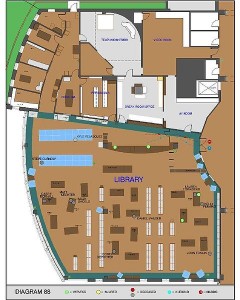
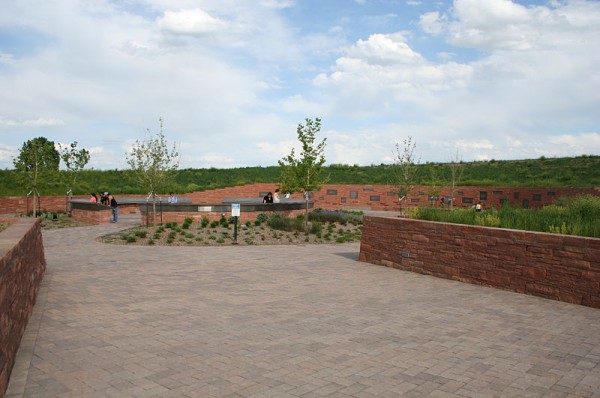
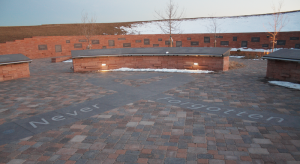
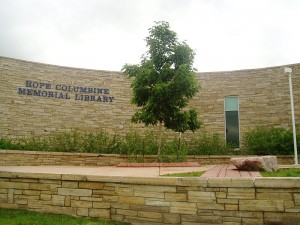
 Follow
Follow